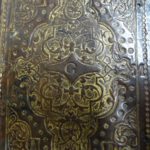52 Weeks of Fantastic Bindings: Week 11
Two early 17th century Edinburgh bindings, possibly the work of Andro Hart and his Heirs
Andro Hart (d. 1621) is best known for being the most successful and important Scottish book merchant and book importer before the Restoration. Hart is first recorded as being a merchant burgess in Edinburgh in 1587, and as a bookseller soon after. By 1608 he was recorded as a master printer operating from his bookshop and printing house, located on the north side of the High Street of Edinburgh. His 1610 edition of the Geneva Bible was the second bible to be printed in Scotland and renowned for its accuracy. The output of his press can be easily recognized by the “A” and “heart” monogram usually found in the ornamental head-pieces found on title pages.
Hart was also a bookbinder, and is listed as such in the Edinburgh Marriage Register when he married his first wife in 22 February 1597. It is unknown how involved Hart was in his binding practice, or where his bindery was located, however, the binding style associated with Hart’s work is very distinct. This style is usually recognized by an elaborate use of gold stamping and tooling, with corner-pieces consisting of a segment of a circle and a large central ornament (usually in an oval shape), and bound with a flat spine that is normally very ornately decorated. University of Glasgow Library’s Bh5-g.14 and The National Library of Scotland’s Bdg.s.127 are both examples of early work in this style.
- The 1611 and 1635 printings of the “Psalmes of David in meeter” by Andro Hart and his Heirs.
- Title page of Andro Hart’s 1611 printing of “Psalmes of David in meeter”.
- Detail of the front board of TypBE.C11HP, showing the distinct binding style of the Hart bindery.
- The smooth spine, rolled and decorated in gold, of TypBE.C11HP.
- Detail of the front board of TypBE.C35HP, possibly the work of the Hart bindery under the auspices of Hart’s heirs.
- Detail of the gauffered edges of TypBE.C35HP.
St Andrews’ recently acquired copy of Hart’s 1611 printing of The Psalmes of David in Meeter, with the prose is another example of the Hart bindery. TypBE.D11HP is bound in a contemporary stained calf on paste boards, with a gold roll-tooled border and with gold stamped centre-piece and cornerpieces with initials “D.G.M.” on both boards, it has a smooth and gold roll-stamped spine, gold tooled board edges, gilt and gauffered fore-edges, and evidence of two ties. This binding fits nicely alongside the other identified Hart bindings.
The Heirs of Andro Hart (namely his sons John and Samuel and his widow Jonet) continued his printing and bookselling business into the mid-1640s. It is not recorded whether his heirs also continued his bindery work, however St Andrews’s copy of the Heirs of Andro Hart’s 1635 printing of The Psalmes of David in Meeter bears a striking resemblence to the earlier works listed above. TypBE.D35HP is bound in contemporary stained calf on boards, with gold ruled and serrated fillets and a gold stamped border with gold stamped centre-piece and corner-pieces and initials “I.B.” on both boards, it, too, has a smooth spine with gold ruled and stamped spine panels, with gold tooled board edges and gold ruled turn-ins, with gauffered fore-edges, and with evidence of two fabric ties. Placed side-by-side, TypBE.D11HP and TypBE.D35HP are almost identical in shape and feel. This work has the same layout as the earlier Hart bindings but shows a sophistication of 20 years of experience, and could be evidence of the Hart bindery’s work under the auspices of Hart’s heirs.
–DG






[...] if the preliminaries of each edition are compared (right), one finds the printer’s device for Andro Hart on the verso of the second leaf of the unattributed edition, in the same position as Finlason’s [...]
[...] if the preliminaries of each edition are compared (right), one finds the printer’s device for Andro Hart on the verso of the second leaf of the unattributed edition, in the same position as Finlason’s [...]
[…] in 1610, it was only the second edition of the Bible printed in Scotland and the product of a skilled bookbinder, Andro Hart. The antiquity of that bible in 1685, suggests that Alexander McCubbin’s kin had purchased it […]
[…] if the preliminaries of each edition are compared (right), one finds the printer’s device for Andro Hart on the verso of the second leaf of the unattributed edition, in the same position as Finlason’s […]